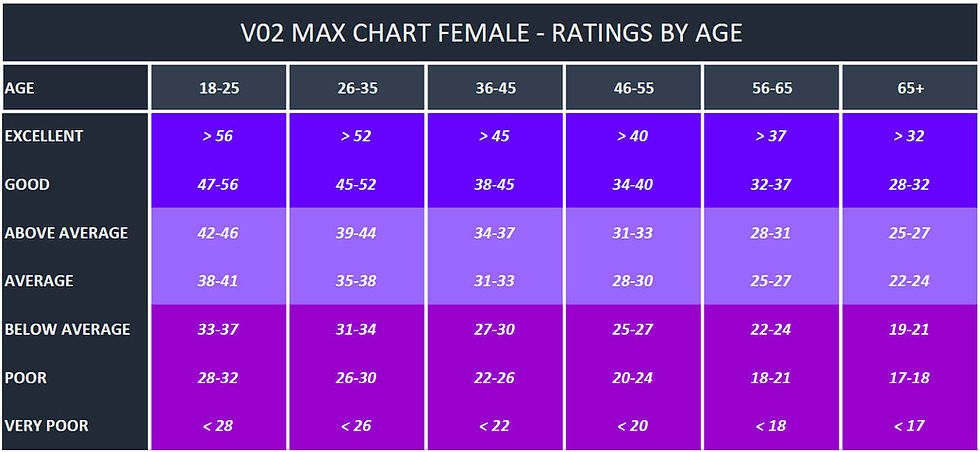What You Didn’t Know About Cardio
- Linked Fit
- Jul 1, 2022
- 7 min read

Cardio involves repetitive full-body movements with light resistance, including body weight or light external resistance. Common examples of such movements include running, swimming, cycling, dancing, jump roping, burpees, etc. Each of these movements stresses the cardiorespiratory system to cause favorable adaptations.
What is the Cardiorespiratory System?
For the body to be able to efficiently utilize oxygen, the respiratory system must sufficiently collect oxygen and the cardiovascular system must have sufficient ability to absorb and transport the oxygen throughout the body.
The cardiorespiratory system is composed of the cardiovascular and respiratory systems and how they intertwine to supply oxygen and nutrients throughout the body. The respiratory system is responsible for the inhalation of oxygen. The oxygen that is inhaled fills air sacs within the lungs and then diffuses into capillaries to become part of the blood. The cardiovascular system transports oxygenated blood from the lungs to the heart and then throughout the rest of the body.

Therefore, in order for the body to be able to efficiently utilize oxygen, the respiratory system must sufficiently uptake oxygen and the cardiovascular system must have sufficient ability to absorb and transport the oxygen throughout the body. During rest and exercise, the functions of the cardiorespiratory system are crucial. The more oxygen that can be supplied to working tissues, the more energy the body is able to produce to sustain activity or simply rest body functions.
The system is also responsible for the removal of carbon dioxide. Carbon dioxide is a byproduct of cellular respiration. As blood carries more oxygen to the tissues, carbon dioxide becomes a part of the blood and is carried to the lungs to be removed via exhalation. Moreover, the cardiorespiratory system moves nutrients such as vitamins and minerals throughout the body, is involved in the transportation of some hormones, and has a role in regulating body temperature.
Cardiorespiratory Fitness Measures
Measurements of cardiorespiratory fitness provide insight into the oxygen uptake and delivery capabilities of the cardiorespiratory system during exercise.

Measurements of cardiorespiratory fitness provide insight into the oxygen uptake and delivery capabilities of the cardiorespiratory system during exercise. The measurements are representative of the intensity of aerobic exercise that one is able to partake in. Maximal oxygen consumption or VO2 max is a measurement of cardiorespiratory fitness. VO2 max describes the greatest amount of oxygen the body is able to uptake and utilize during the aerobic exercise of maximal effort. With a higher VO2 max, one is able to endure greater intensities of aerobic exercise. See the figure below that indicates VO2 max averages based upon age and sex.


Another indication of one’s cardiorespiratory fitness is lactate threshold. Lactate is a byproduct of cellular metabolism when the body does not have enough oxygen to undergo full aerobic metabolism. The lactate threshold is the speed of movement or the percent of VO2max when lactate is present in the blood above resting levels. Since lactate is produced in the absence of oxygen, its presence during aerobic exercise is an indication that the cardiorespiratory system is no longer able to keep up with oxygen demands for the activity. When one continues to exercise above the lactate threshold fatigue starts to develop.
Aerobic Endurance Training and Acute Changes
Mechanisms of the cardiorespiratory system alter to keep up with the demands of the exercise and provide more oxygen to working tissues.
Aerobic endurance exercise traditionally consists of full-body repetitive movements that extend a duration longer than three minutes and are often completed for at least 10 minutes. Some examples of aerobic endurance exercise include running, biking, rowing, and swimming. On top of that, aerobic adaptations have been produced from training efforts that are not continuous. An example includes high-intensity interval training that comprises high-intensity work efforts at or above 90% VO2 max interspersed with short rest periods (Lanzi et. al., 2015).
Aerobic endurance exercise taxes the cardiorespiratory system. Therefore, mechanisms of the cardiorespiratory system alter to keep up with the demands of the exercise and provide more oxygen to working tissues. As it is commonly known, when one starts to exercise their breathing rate and heart rate start to increase. The increase in breathing rate allows more oxygen to be collected and the increase in heart rate shows that the heart is contracting more often to expel oxygenated blood throughout the body.

During exercise, the heart also has an increase in the amount of blood it is able to pump, known as end-diastolic volume. This increase in the blood allows for an increase in stroke volume, the amount of oxygenated blood pumped out by the heart with each contraction, and an increase in cardiac output, the amount of blood pumped by the heart after one minute. The increase in heart rate and the amount of blood pumped by the heart allows for greater blood flow to active muscles.
To further increase the ability to work muscles to receive oxygenated blood, manipulation of nervous system hormones causes dilation of arterioles local to working muscles and constriction of arterioles to other organ systems.
Long-Term Adaptations to Aerobic Endurance Training
Improved oxygen uptake and delivery capabilities increase the aerobic intensity that can be endured, while at the same time muscular adaptations support the ability to prolong aerobic activity.

Consistent aerobic endurance training causes the cardiorespiratory system to adapt to the stimulus it experiences. The adaptations that occur improve oxygen uptake and delivery capabilities, thus increasing the aerobic intensity that can be endured. Increased blood circulation during exercise results from an increased stroke volume and thus maximal cardiac output, and an increase in the size and strength of the left ventricle of the heart (the chamber that contracts to push oxygenated blood throughout the body). In relation to the increased stroke volume and contraction capabilities of the heart, there is a reduction in heart rate during rest and submaximal exercise. Therefore, exertion is less during submaximal exercise due to the heart not needing to pump as often because it can pump more blood with each contraction.
Muscles also experience adaptations to aerobic training that increase the aerobic stress they can handle. With progressive aerobic training, muscle fiber types transition to support aerobic activity and delay fatigue. Specifically, there is selective hypertrophy of type I muscle fibers, which are fibers that are mainly involved in the aerobic muscular effort and are able to support longer duration activity before experiencing fatigue. The higher prevalence of these fibers supports the ability to partake in more intense and longer durations of aerobic activity, such as running longer distances while maintaining a specific pace.
Another muscular adaptation includes increased efficiency of locomotion, therefore, fewer calories are needed to fuel the activity. Moreover, muscles become more accustomed to utilizing fat as a fuel source, a more dense energy source providing more calories per gram. The result of both these adaptations is a greater ability to prolong aerobic activity.
Performance measures such as VO2 max and lactate threshold also increase as a chronic adaptation. As the cardiorespiratory system develops an enhanced ability to intake oxygen via increased tidal volume (amount of air moved in and out of the lungs with each breath) and move oxygenated blood to work tissues, VO2 max is increased. On a similar note, as muscles increase their aerobic capacity via adaptations to muscle fibers including an increase in the number and size of mitochondria (the organelle that is responsible for producing energy via aerobic respiration) lactate threshold increases.
Aerobic Endurance Training Techniques
The technique one chooses may depend on the specific training goal one has.
There are many different training techniques to train aerobic capacity and develop adaptations. The technique one chooses may depend on the specific training goal they have, whether it be increasing the distance they can handle or increasing the intensity, or speed they can handle. If one does not have a specific goal they may choose what they find most enjoyable.
Long slow distance training involves completing a training modality at a lower intensity for longer distances. If one is preparing for a race, this type of training involves a slower than race pace and longer than race distance. Intensity should be set at around 80% of one’s heart rate max. Without determining heart rate, a sufficient way to determine a good intensity is to pick a pace that one is able to still talk during training. A typical duration may range from thirty minutes to two hours.
Pace/tempo training involves training at one’s lactate threshold. If training for a race, this type of training helps the individual to develop a sense of race pace and become more accustomed to maintaining such pace.
High-intensity interval training (HIIT) has become a popular method to improve aerobic endurance. It involved high-intensity exercise with brief rest periods. Intervals can range from 45 seconds to 4 minutes and rest intervals vary depending on the intensity of the work completed. The goal of HIIT training is to spend several minutes at or above an intensity of 90% of one’s VO2 max. Intensity can also be determined by monitoring heart rate. 90% of one’s VO2max corresponds to about 95% of one’s heart rate max.
Fartlek training includes a combination of long slow distance training, pace tempo training, and interval training. Including a combination of intensities and durations may help to reduce boredom during training. Fartlek training can include running, cycling, or swimming. An example of Fartlek training may include combining easy running with uphill sprints.
Concluding Thought
In conclusion, aerobic endurance training provides many adaptations to the cardiorespiratory system. It improves the ability of the heart and lungs to work together to deliver oxygen and nutrients throughout the body, while also eliminating waste products. Enhanced functioning of the cardiorespiratory systems provides ease during everyday activities and decreases the risk of certain diseases, such as cardiovascular disease. It is important to find a type of aerobic training that one enjoys and can stick to in order to develop long-term adaptations. Continually increasing the stress on the cardiorespiratory system will cause further adaptations, allowing the body to withstand higher intensities and helping one to reach their training goals.

References
Clark, M. A., Sutton, B. G., & Lucett, S. C. (Eds.). (2014). Nasm Essentials of Personal Fitness Training. Jones & Bartlett Learning.
Lanzi, Codecasa, F., Cornacchia, M., Maestrini, S., Capodaglio, P., Brunani, A., Fanari, P., Salvadori, A., & Malatesta, D. (2015). Short-term HIIT and Fat(max) training increase aerobic and metabolic fitness in men with class II and III obesity. Obesity (Silver Spring, Md.), 23(10), 1987–1994. https://doi.org/10.1002/oby.21206
National Strength and Conditioning Association [NSCA]. (2016). Essentials of strength training and conditioning. (G. Haff & N. T. Triplett, Eds.). Human Kinetics.
Comments